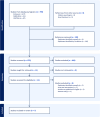Aspirin Versus LMWH for Thromboprophylaxis Following Hip or Knee Arthroplasty-Clinical Implications and Budget Impact
- PMID: 40620160
- PMCID: PMC12230501
- DOI: 10.1002/prp2.70147
Aspirin Versus LMWH for Thromboprophylaxis Following Hip or Knee Arthroplasty-Clinical Implications and Budget Impact
Abstract
Venous thromboembolism (VTE) remains a significant concern for patients undergoing hip or knee arthroplasty, with a need to balance effective thromboprophylaxis and bleeding risk. We aimed to compare the efficacy, safety, and budget impact of aspirin versus low-molecular-weight heparin (LMWH) as sole thromboprophylactic agents initiated immediately postoperatively in this population. First, we conducted a systematic review of randomized controlled trials (RCTs) from Ovid MEDLINE, Embase, and Cochrane CENTRAL databases, assessing clinical outcomes and healthcare costs. Subsequently, a simplified budget impact analysis was performed using data from the largest identified and most recent RCT (CRISTAL trial) and its secondary analyses. Primary outcomes included symptomatic VTE, bleeding events, and reoperation rates. Through a systematic search, seven RCTs were considered to be eligible, with the CRISTAL trial providing the most compelling evidence. Aspirin was non-inferior to LMWH for all-cause mortality but was associated with a significantly higher symptomatic VTE rate (3,27% vs. 1,76%) and deep vein thrombosis (DVT), predominantly distal DVT. The budget impact analysis revealed that despite aspirin's lower per tablet cost, thromboprophylaxis with LMWH led to annual savings of $35,912,459 to $110,431,241 for U.S. healthcare stakeholders, and $17,075 to $56,450 for single hospitals performing 1000 arthroplasty procedures annually. To conclude, enoxaparin appears to offer superior clinical efficacy and cost-effectiveness compared to aspirin for thromboprophylaxis following hip and knee arthroplasty. These findings support the preferential use of LMWH in this setting, while highlighting the need for further investigation into the clinical significance of aspirin's higher distal DVT and pulmonary embolism risk.
Keywords: aspirin; low‐molecular‐weight heparin; orthopedics; thromboprophylaxis.
© 2025 The Author(s). Pharmacology Research & Perspectives published by British Pharmacological Society and American Society for Pharmacology and Experimental Therapeutics and John Wiley & Sons Ltd.
Conflict of interest statement
The authors declare no conflicts of interest.
Figures
Similar articles
-
Anticoagulants (extended duration) for prevention of venous thromboembolism following total hip or knee replacement or hip fracture repair.Cochrane Database Syst Rev. 2016 Mar 30;3(3):CD004179. doi: 10.1002/14651858.CD004179.pub2. Cochrane Database Syst Rev. 2016. PMID: 27027384 Free PMC article.
-
The efficacy of aspirin versus low-molecular-weight heparin for venous thromboembolism prophylaxis after knee and hip arthroplasty: A systematic review and meta-analysis of randomized controlled trials.Knee Surg Sports Traumatol Arthrosc. 2025 May;33(5):1605-1616. doi: 10.1002/ksa.12456. Epub 2024 Sep 3. Knee Surg Sports Traumatol Arthrosc. 2025. PMID: 39228215 Free PMC article.
-
Primary prophylaxis for venous thromboembolism in ambulatory cancer patients receiving chemotherapy.Cochrane Database Syst Rev. 2016 Dec 1;12(12):CD008500. doi: 10.1002/14651858.CD008500.pub4. Cochrane Database Syst Rev. 2016. Update in: Cochrane Database Syst Rev. 2020 Dec 18;12:CD008500. doi: 10.1002/14651858.CD008500.pub5. PMID: 27906452 Free PMC article. Updated.
-
Pentasaccharides for the prevention of venous thromboembolism.Cochrane Database Syst Rev. 2016 Oct 31;10(10):CD005134. doi: 10.1002/14651858.CD005134.pub3. Cochrane Database Syst Rev. 2016. PMID: 27797404 Free PMC article.
-
Home versus in-patient treatment for deep vein thrombosis.Cochrane Database Syst Rev. 2018 Jan 9;1(1):CD003076. doi: 10.1002/14651858.CD003076.pub3. Cochrane Database Syst Rev. 2018. PMID: 29315455 Free PMC article.
References
-
- Salazar C. A., Basilio Flores J. E., Malaga G., Malasquez G. N., and Bernardo R., “Direct Factor Xa Inhibitors Versus Low Molecular Weight Heparins or Vitamin K Antagonists for Prevention of Venous Thromboembolism in Elective Primary Hip or Knee Replacement or Hip Fracture Repair,” Cochrane Database of Systematic Reviews 27, no. 1 (2025): CD011762. - PMC - PubMed
-
- Agarwal A. R., Das A., Harris A., et al., “Trends of Venous Thromboembolism After Total Hip Arthroplasty in the United States: Analysis From 2011 to 2019,” Journal of the American Academy of Orthopaedic Surgeons 31 (2023): e376–e384. - PubMed
Publication types
MeSH terms
Substances
LinkOut - more resources
Full Text Sources
Medical


